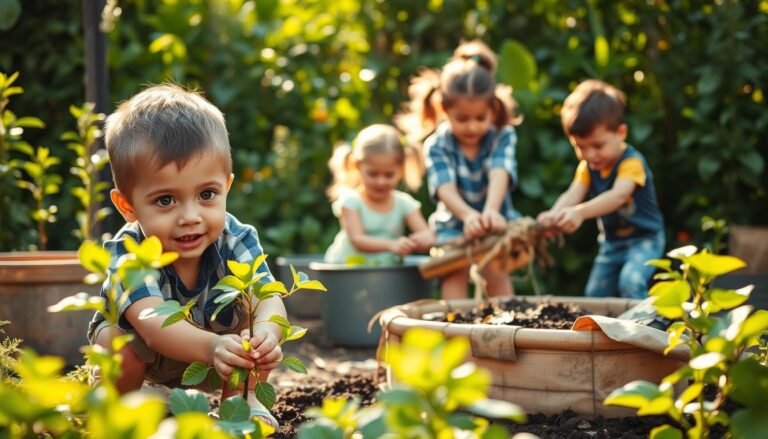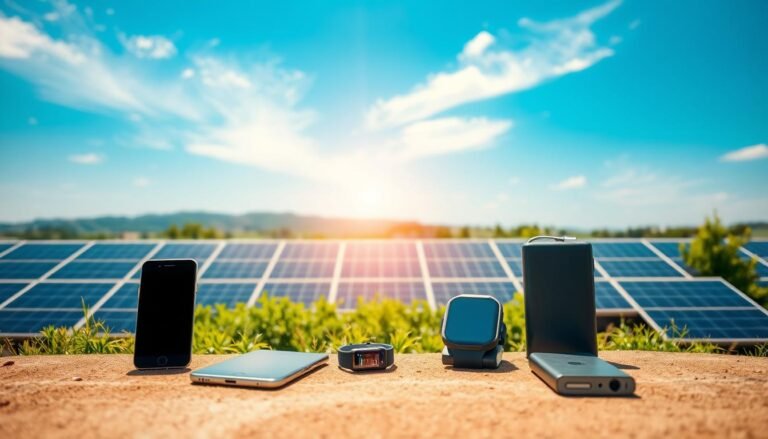Key Takeaways
- Small sustainable choices create significant environmental impact when practiced consistently
- Eco-friendly family routines can be budget-friendly and time-efficient
- Children who grow up with sustainable practices develop lifelong environmental values
- Starting with just one area of sustainability makes the transition manageable
- Community engagement amplifies the impact of individual family choices
Making sustainable choices for families isn’t just about protecting the environment—it’s about creating a healthier future for our children. As parents, we have the unique opportunity to shape how the next generation views their relationship with the planet. Every small decision, from the products we purchase to the habits we practice, contributes to our family’s environmental footprint.
The good news? You don’t need to overhaul your entire lifestyle overnight. Sustainable living works best when approached as a journey of gradual, intentional changes that align with your family’s values and circumstances. This guide will help you navigate practical eco-friendly options that work in real family life—where convenience matters and budgets are often tight.
Teaching children sustainable practices through hands-on activities creates lasting environmental values
Eco-Friendly Daily Routines for Families
The most effective sustainable choices for families are those that become part of your everyday routine. These small habits require minimal effort but create significant environmental benefits when practiced consistently.
Morning Routines That Save Energy and Water
Morning routines offer multiple opportunities to reduce your family’s environmental impact. Consider shorter showers (try a shower timer for kids), turning off water while brushing teeth, and using natural light instead of electric lighting whenever possible.
Teaching children to unplug chargers and turn off lights when leaving rooms creates energy awareness that becomes second nature. These simple actions reduce your carbon footprint while lowering utility bills—a win for both the planet and your budget.

Mealtime Sustainability Practices
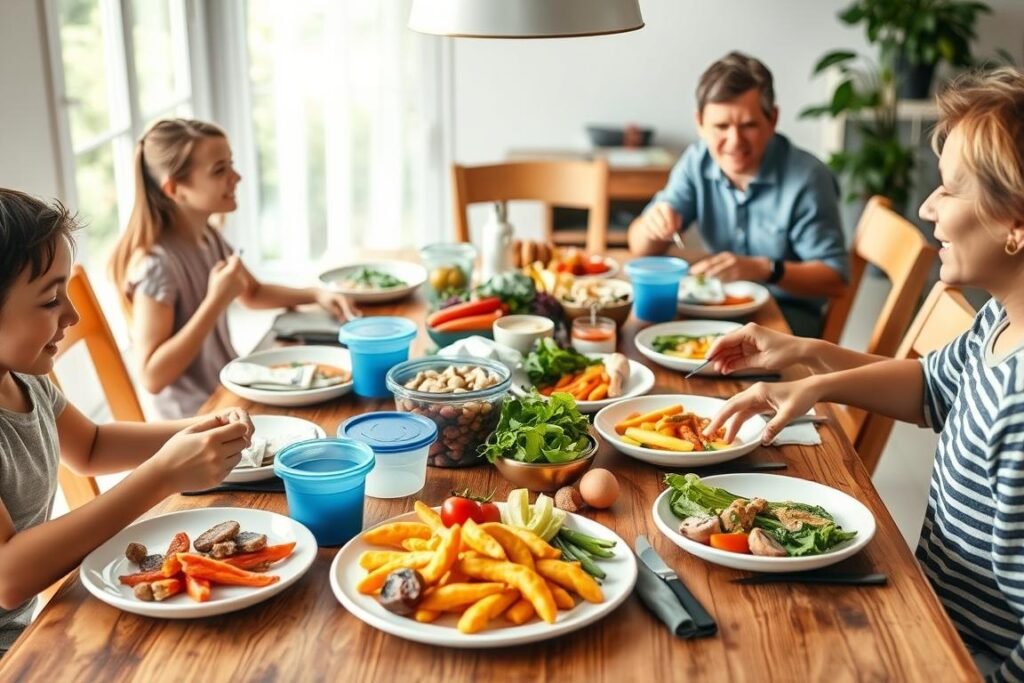
Food choices represent some of our most impactful environmental decisions. Consider implementing a weekly meal plan to reduce food waste and grocery trips. Introduce “Meatless Monday” as a fun way to explore plant-based recipes that reduce your carbon footprint.
Replace single-use items with reusable alternatives: cloth napkins instead of paper, beeswax wraps instead of plastic wrap, and durable containers instead of disposable bags. Involve children in meal preparation using locally sourced ingredients to teach them about food origins and seasonal eating.
Bedtime Routines That Save Resources
Evening routines offer additional opportunities for sustainable practices. Set programmable thermostats to reduce heating and cooling during sleeping hours. Create a “power down” ritual where family members help unplug non-essential electronics before bed.
Reading by LED lighting or natural light when possible, and using rechargeable batteries for nightlights and children’s toys reduces energy consumption and waste. These small adjustments quickly become habits that children will carry into adulthood.
Mindful Shopping: Sustainable Choices for Family Purchases
Every purchase decision represents an opportunity to make more sustainable choices for your family. The key is developing a more thoughtful approach to consumption rather than defaulting to convenience.
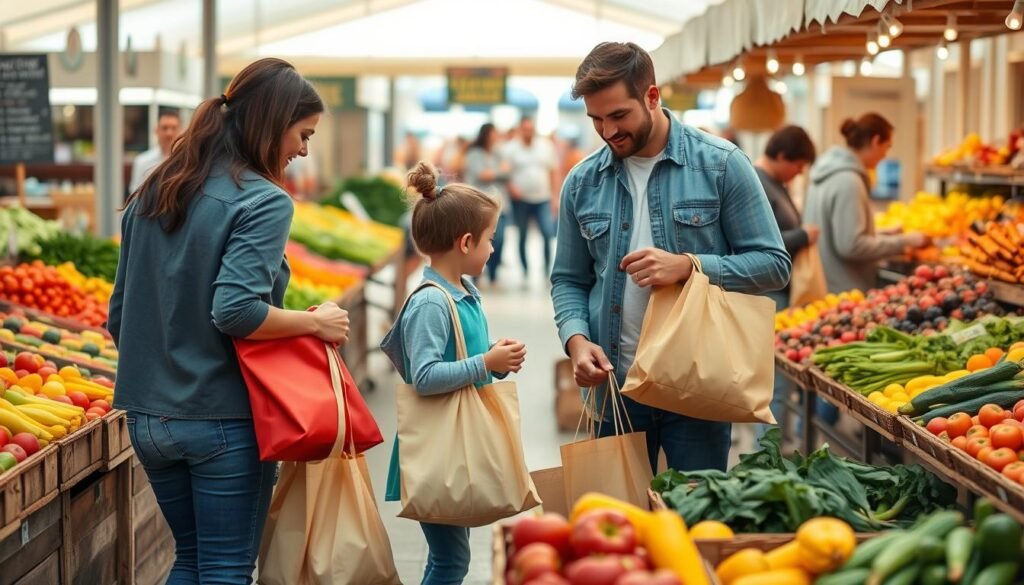
Shopping at local markets reduces packaging waste and transportation emissions
The “Do We Need It?” Pause
Before making any purchase, implement the simple practice of pausing to ask: “Do we really need this?” This small moment of reflection can significantly reduce impulse buying and unnecessary consumption. Teach children this habit early by involving them in discussions about wants versus needs.
When you do need to make a purchase, consider buying secondhand first. Thrift stores, online marketplaces, and community swap events offer quality items without the environmental impact of new production. This approach is particularly effective for quickly outgrown children’s clothing, toys, and sports equipment.
Choosing Products with Less Environmental Impact
When purchasing new items, look for products with minimal packaging, recyclable materials, and longer lifespans. Opt for concentrated cleaning products that require less plastic and shipping weight. Choose items made from sustainable materials like bamboo, organic cotton, or recycled content.
Teach children to recognize eco-friendly packaging symbols and involve them in making more sustainable choices. This builds critical thinking skills and environmental awareness that will serve them throughout life.

Budget-Friendly Eco Products for Families
Sustainable living doesn’t have to break the bank. These affordable eco-friendly product swaps can actually save money over time while reducing your family’s environmental impact.
Kitchen Essentials
- Reusable food storage bags ($10-15 for a set that lasts years)
- Beeswax or silicone food wraps ($15-20, replacing hundreds of plastic wrap rolls)
- Cloth napkins ($10-15 for a set that eliminates paper napkin waste)
- Compostable dish brushes ($5-8, replacing plastic sponges)
Bathroom Swaps
- Bamboo toothbrushes ($3-5 each, biodegradable handles)
- Shampoo and conditioner bars ($8-15, eliminating plastic bottles)
- Safety razors ($15-30 initial investment, then just replacement blades)
- Reusable cotton rounds ($10-15 for a set that replaces disposables)
Family Basics
- Reusable water bottles ($10-20 each, preventing hundreds of plastic bottles)
- Cloth shopping bags ($1-5 each, eliminating plastic bag waste)
- Rechargeable batteries ($15-25 starter set, replacing disposables)
- LED light bulbs ($2-5 each, using 75% less energy than incandescents)
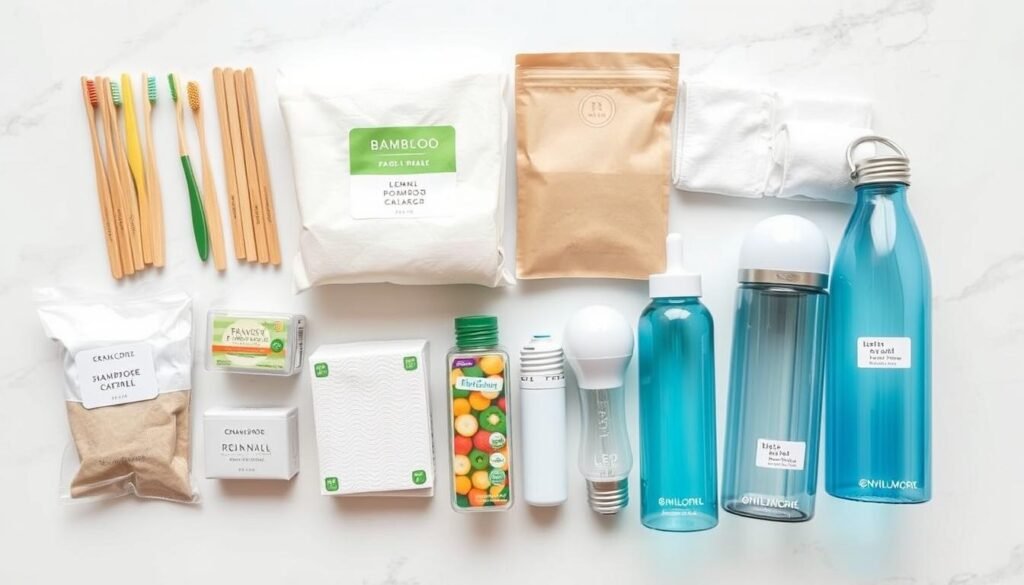
Many eco-friendly products pay for themselves through reduced need for disposable alternatives
Children’s Products Worth the Investment
Some sustainable choices for families require a larger upfront investment but offer significant savings over time. Consider these options when your budget allows:
- Cloth diapers ($200-300 starter set, saving $1,000+ over disposables)
- Stainless steel lunch containers ($20-40 set, lasting through years of school lunches)
- Quality wooden toys ($15-50 each, outlasting plastic alternatives for years)
- Solar-powered educational toys ($15-30, eliminating battery waste)

Sustainable Toy Alternatives and Play Ideas
Children’s play offers countless opportunities for introducing sustainable choices for families. By rethinking toys and activities, you can reduce waste while encouraging creativity and connection with nature.
Eco-Friendly Toy Options
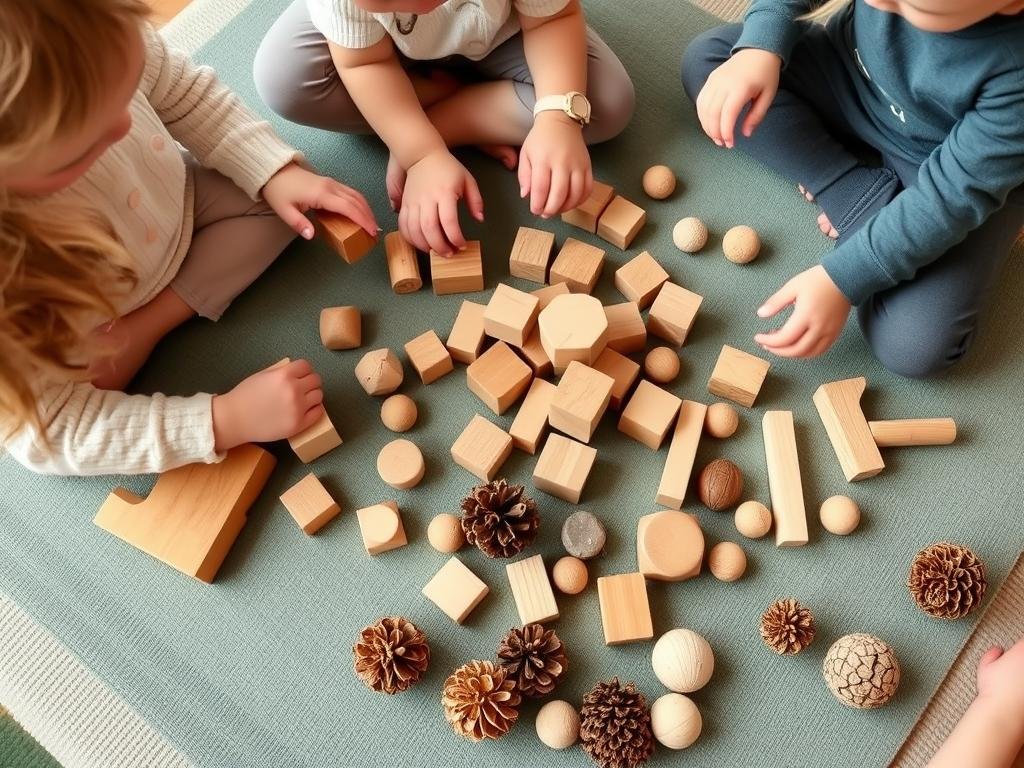
When selecting toys, look for items made from sustainable materials like FSC-certified wood, organic cotton, or recycled plastics. Choose quality over quantity, focusing on versatile toys that grow with your child and encourage open-ended play.
Consider toy libraries and subscription services that allow children to enjoy new toys without the environmental impact of ownership. Organize toy swaps with other families to refresh your child’s play options without purchasing new items.
Nature-Based Activities
Some of the most engaging and beneficial play experiences for children cost nothing and have zero environmental impact. Regular outdoor time in natural settings provides developmental benefits while fostering environmental appreciation.
Backyard Adventures
- Create a nature scavenger hunt
- Build a simple bird feeder from recycled materials
- Start a small container garden with food scraps
- Construct a bug hotel from natural materials
Community Exploration
- Participate in local park clean-ups
- Visit farmers markets and talk to local growers
- Join community garden projects
- Explore walking trails and identify local plants
Indoor Nature Connection
- Create art from natural materials
- Start windowsill herbs from kitchen scraps
- Make homemade play dough with natural ingredients
- Upcycle household items into creative projects
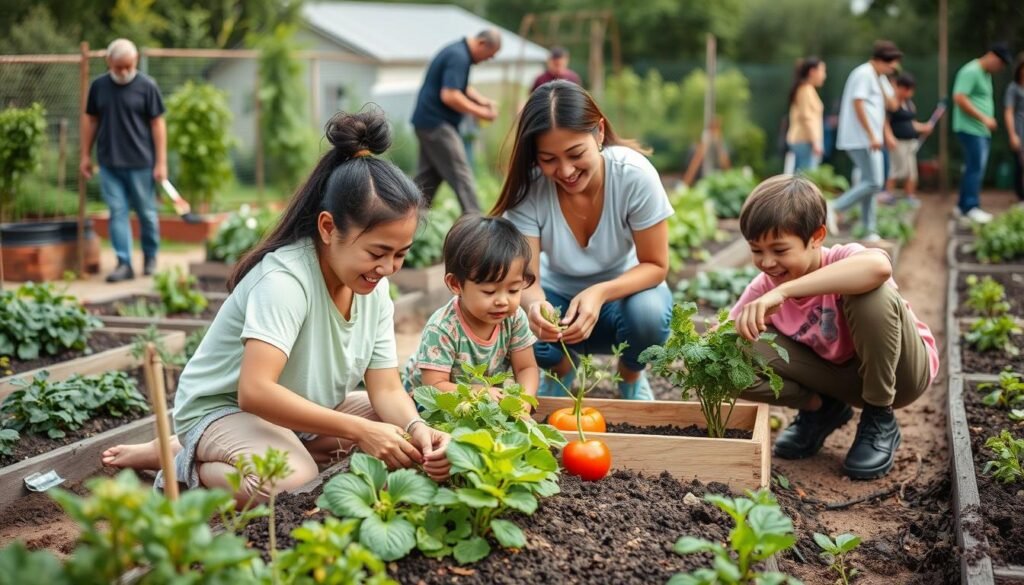
Community gardens teach children about food systems while building neighborhood connections
Common Challenges and Practical Solutions
Adopting sustainable choices for families often comes with obstacles. Acknowledging these challenges and finding workable solutions makes the journey more manageable.
Challenges
- Limited time for eco-friendly practices
- Higher upfront costs of sustainable products
- Resistance from family members
- Convenience of disposable options
- Conflicting information about what’s truly sustainable
Solutions
- Focus on time-saving sustainable swaps first
- Calculate long-term savings of reusable items
- Start with changes everyone can agree on
- Prepare reusable options in advance
- Focus on imperfect progress over perfection
When Budget Constraints Feel Limiting
Financial considerations often present the biggest barrier to sustainable choices for families. Remember that the most impactful environmental actions—consuming less, reusing what you have, and reducing waste—actually save money rather than costing more.
“The most sustainable product is the one you already own. Using what you have until it truly needs replacement is often more environmentally friendly than buying new ‘green’ products.”
Start with no-cost changes like reducing energy use, planning meals to minimize food waste, and repurposing items you already own. As you save money through these practices, you can gradually invest in quality sustainable products that offer long-term value.
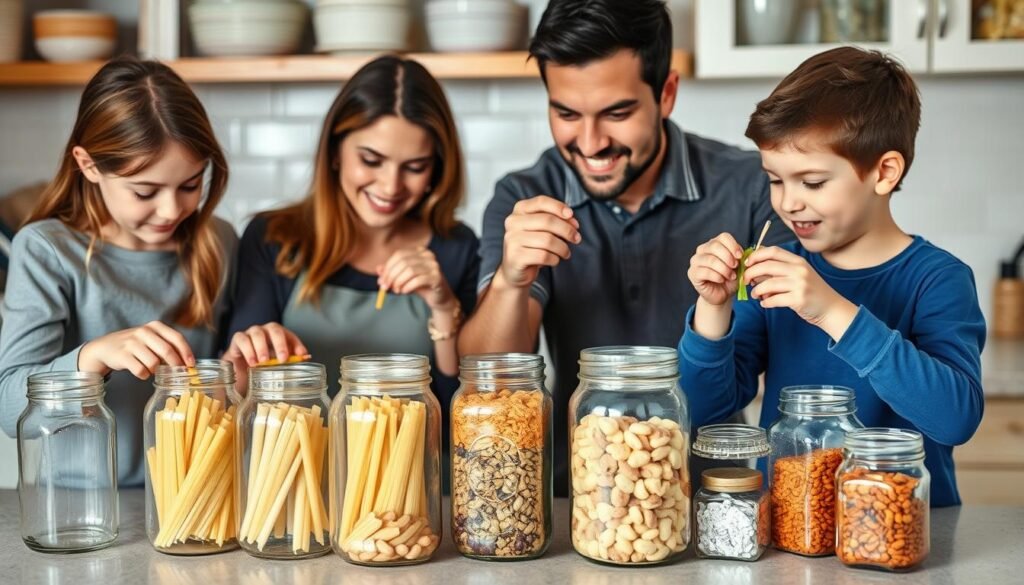
Repurposing existing containers reduces waste while saving money on storage solutions
Managing Time Constraints
Many families avoid sustainable practices because they seem time-consuming. The key is identifying eco-friendly options that actually simplify rather than complicate your routine.
Meal planning reduces both food waste and last-minute grocery trips. Decluttering creates a more manageable home with fewer items to clean and maintain. Choosing quality products means less frequent shopping and replacement. These approaches save time while reducing environmental impact.
Teaching Sustainability Values to Children
Perhaps the most important aspect of sustainable choices for families is how they shape children’s values and worldview. When sustainability becomes part of everyday family life, children develop environmental consciousness that lasts a lifetime.
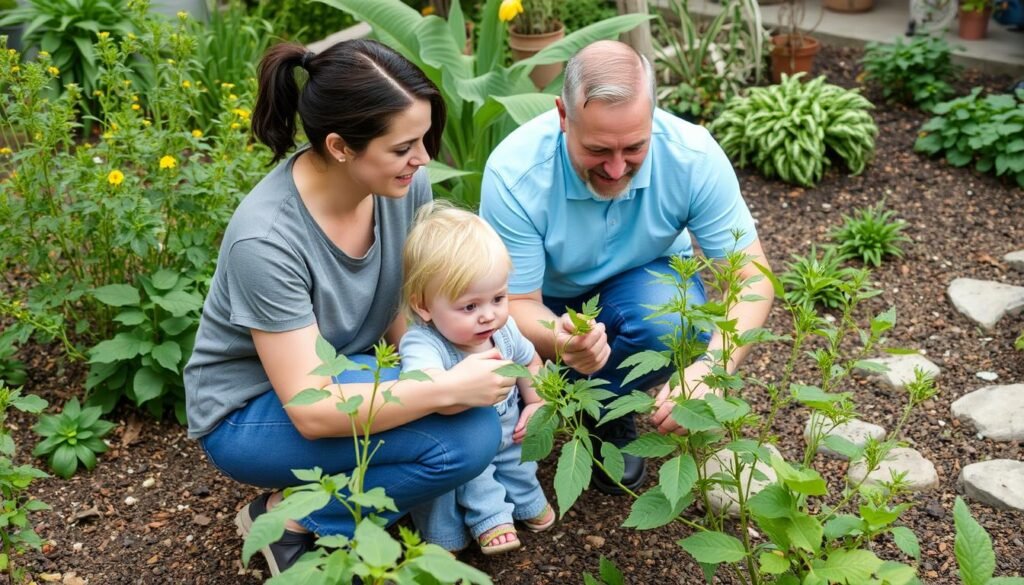
Hands-on experiences in nature build children’s environmental awareness and appreciation
Age-Appropriate Environmental Education
Ages 2-5
- Simple sorting for recycling
- Helping water plants
- Turning off lights when leaving rooms
- Basic nature exploration and appreciation
Ages 6-9
- Understanding where food comes from
- Participating in meal planning to reduce waste
- Learning about water conservation
- Helping with composting
Ages 10-13
- Researching eco-friendly alternatives
- Calculating family carbon footprint
- Planning and tending a garden
- Participating in community environmental projects
Teens
- Understanding complex environmental issues
- Making independent sustainable choices
- Advocating for environmental policies
- Considering sustainability in career planning
Making Sustainability Fun and Engaging
Children learn best through positive experiences rather than obligation. Create family challenges like a “zero-waste weekend” or “electricity-free evening” that turn sustainable practices into adventures. Celebrate successes and focus on the joy of connection with nature rather than guilt or fear about environmental problems.

Connect with other eco-conscious families to share ideas and create community around sustainable living. Children who see sustainability as a normal part of their social world are more likely to maintain these values throughout life.
Extending Your Impact Beyond Your Home
Individual sustainable choices for families create important environmental benefits, but their impact multiplies when connected to broader community action.
Neighborhood Sustainability Initiatives
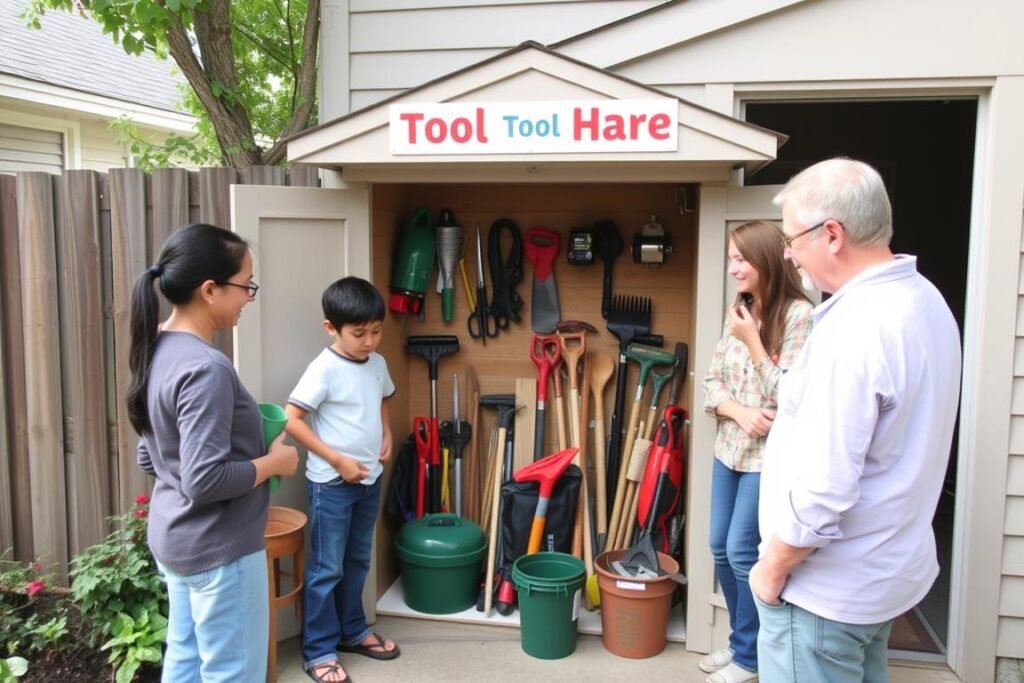
Consider starting or joining local sustainability initiatives that amplify individual efforts. Tool-sharing libraries reduce the need for every household to own rarely-used items. Community composting turns collective food waste into valuable garden resources. Neighborhood garden projects create local food sources while building connections.
These community-based approaches not only increase environmental impact but also create supportive social networks that make sustainable living more accessible and enjoyable for all families involved.
Advocating for Systemic Change
While individual choices matter, many environmental challenges require policy and systemic changes. Teach children that their voice matters by engaging in age-appropriate advocacy. Attend community meetings about environmental issues, write to representatives about sustainability concerns, and support businesses and organizations aligned with your environmental values.
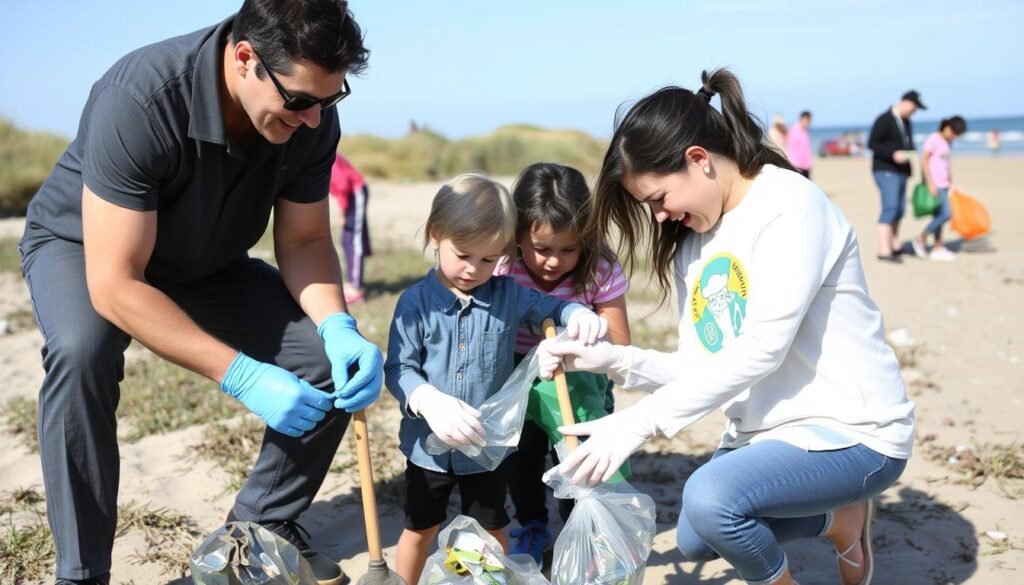
Community clean-up events demonstrate how collective action creates visible environmental improvements
Embracing the Sustainable Family Journey
Making sustainable choices for families isn’t about achieving perfection—it’s about consistent progress toward a lifestyle that reflects your values. Every small change contributes to both environmental protection and raising children who understand their connection to the natural world.
Start where you are, with the resources you have. Choose one area of sustainability that resonates with your family and build from there. Celebrate progress rather than focusing on perfection, and remember that the most important outcome is raising children who carry environmental consciousness into their future.
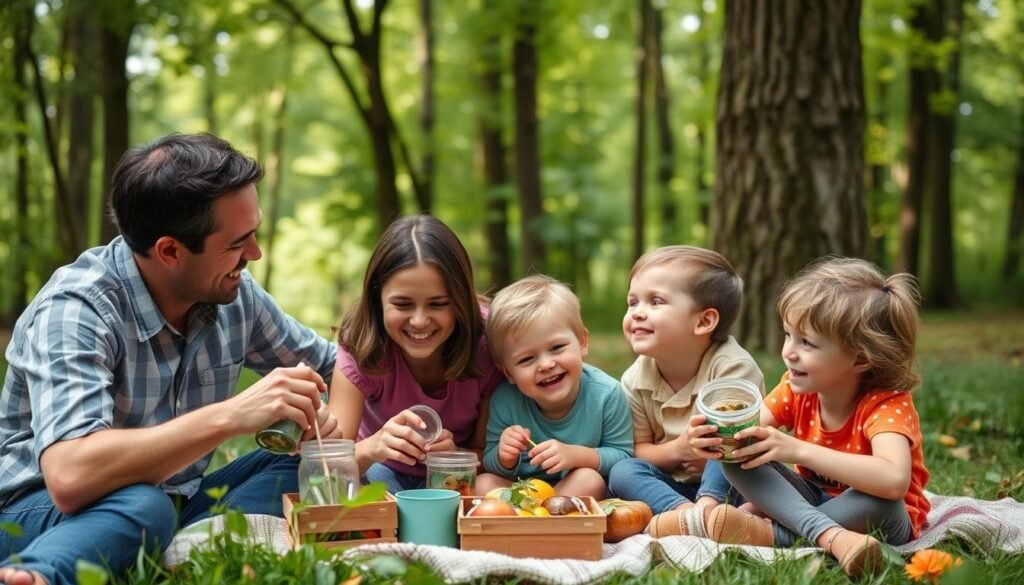
Sustainable living creates meaningful connections to nature and each other
Share Your Family’s Sustainable Journey
What sustainable practices have worked best for your family? Share your experiences in the comments below or join our community forum to connect with other eco-conscious families. Your ideas might be exactly what another family needs to take their next step!
Frequently Asked Questions About Sustainable Family Living
Isn’t sustainable living more expensive for families?
While some eco-friendly products have higher upfront costs, many sustainable practices actually save money over time. Reducing consumption, reusing items, conserving energy and water, and minimizing food waste all reduce household expenses. Start with changes that save rather than cost money, then gradually invest in quality sustainable products as your budget allows.
How do I get my children interested in sustainability?
Children naturally connect with nature and respond to positive engagement rather than obligation. Focus on fun, hands-on activities like gardening, nature exploration, and creative reuse projects. Emphasize the immediate benefits they can see and experience rather than abstract environmental concepts. Most importantly, model the behaviors you want to encourage.
What if other family members aren’t on board with sustainable changes?
Start with changes that offer clear benefits everyone can appreciate, like cost savings or health improvements. Focus on one area at a time rather than trying to change everything at once. Involve reluctant family members in choosing which sustainable practices to adopt first, giving them ownership in the process. Celebrate small successes and be patient with the transition.
